2025 Ducati Panigale V4 and V4 S – First Look

Updated engine, electronics, frame, and *GASP* double-sided swingarm
As we predicted, Ducati revealed a new Panigale V4 for 2025, announcing updates to its engine, chassis and electronics and ushering in what it calls the seventh generation of Ducati Superbikes. The new 2025 Ducati Panigale V4 will be priced at $25,995 in the U.S., with the higher performance Panigale V4 S coming in at $33,895. Both versions should arrive in dealerships in September.
In designing the new Panigale V4, Ducati says it drew inspiration from the legendary 916, with innovations inherited from its championship-winning Desmosedici GP MotoGP racebike. Ducati says it focused on three main themes: improving overall performance, decreasing riding effort, and raising the floor of what the average rider is capable of achieving on a superbike.
Visually, Ducati gave the Panigale V4 its biggest styling change since it replaced the V-Twin model as its top-tier sportbike. Gone are the gill-shaped vents on either side, and in their place are one large upper vent behind the radiator, and a slimmer slit behind the oil cooler. Red bodywork flows from the tank to the tail, creating a sense of horizontality that draws inspiration from both the Ducati 916 and the current MotoGP bikes. The leading edge of the fairing was also reshaped to create more room around the front wheel, a design element inherited from the Desmosedici GP that Ducati claims to make the Panigale more nimble when changing directions at speed.
Once a novelty and now commonplace among high-performance bikes, the winglets are now color matched and more fully integrated into the fairing with a new double-profile design. The dual headlights and V-shaped daytime running lights adopt a slimmer look, though some of that comes from changing the air intake into a single, central unit hidden under the fairing.
Overall, Ducati says the new fairing reduces aerodynamic resistance by 4%, creating a more effective bubble of calm air around the rider in a straight line.
Ducati updated the riding ergonomics to better take advantage of the aerodynamics while also improving overall control. The seat is longer and wider, allowing for more freedom of movement while also providing more support during braking and through corners. The footrests are now 0.4 inches closer together compared to the previous Panigale V4, improving aerodynamics and also providing a bit more ground clearance. Ducati also reshaped the fuel tank curve to make it easier for a rider’s knees to gain a grip during deceleration or when leaning off the saddle in a corner.
As we previously reported, the Panigale V4 receives an updated engine for 2025. It’s still a 1,103cc 90° V-Four Desmosedici Stradale with a counter-rotating crankshaft and Twin-pulse firing, but Ducati changed the profile of the cams and increased valve lift. The engine inherits the alternator and oil pump from the Panigale V4 R, while the gearbox drum is now the same as the one used on the Superlegerra V4. Ducati also adjusted the variable length intake horns, reducing the short configuration to 25 mm (from 35 mm) and increasing the long configuration to 80 mm from 75 mm.
The Desmosedici Stradale engine is now Euro 5+ homologated, with Ducati claiming an output of 216 hp at 13,500 rpm and 89.0 lb-ft. at 11,250 rpm, though U.S.-bound models have different figures, claiming 209 hp at 12,750 rpm and 89.5 lb-ft. at 11,250 rpm. An accessory Akrapovič racing exhaust will unlock more power, with Ducati claiming a peak output of 228 hp for models outside the U.S.
For the chassis, Ducati looked to optimize lateral stiffness without reducing longitudinal stiffness. To this end, Ducati modified the front frame and, in a move that some people would appreciate less than others, a new double-sided swingarm.
Ducati says it developed two new swingarm designs, a single-sided swingarm and a double-sided unit, and sought feedback from its test riders. Ultimately, the double-sided swingarm won out. Dubbed the Ducati Hollow Symmetrical Swingarm, the unit claims a 37% reduction in lateral stiffness and lighter weight.
The front frame is also lighter than the previous frame, with Ducati claiming a 40% reduction in lateral stiffness.
The 2025 Panigale V4 S comes equipped with a third-generation electronically controlled Öhlins NPX-30 fork, TTX 36 rear shock, and steering damper, while the non-S model makes do with a 43 mm Showa Big Piston Fork and Sachs monoshock (both fully adjustable) and Sachs steering damper.
The braking system is all new, with the 2025 Panigale V4 models being the first models to come equipped with Brembo’s Hypure front brake calipers. Brembo claims the calipers are 10% lighter than competing units while dispersing heat more effectively. The Panigale V4 is also the first to receive Bosch’s Race electronic Combined Braking System (eCBS). Dedicated to track-use only, Race eCBS applies rear brake pressure when just the front brake lever is pulled and mimicking the riding techniques of professional racers, delaying the braking point as long as possible through corners, even continuing to apply a bit of rear brake pressure after the front brake lever is released.
Ducati developed a new electronics package for the Panigale V4, dubbed the Ducati Vehicle Observer (DVO). Developed by Ducati’s MotoGP racing program, DVO estimates the ground forces applied to a motorcycle to calculate the maximum load it can bear in various riding conditions with information from the IMU inertial platform. The package includes Ducati Traction Control DVO, Ducati Slide Control, Ducati Wheelie Control DVO, Ducati Power Launch DVO, and Engine Brake Control. The Panigale V4 also comes with Ducati Quick Shift 2.0, which operates using the angular position sensor of the shifting drum, with Ducati claiming more direct feedback and reduced travel.
Helping manage the electronics is a new 6.9-inch TFT display with an 8:3 aspect ratio. The display uses Optical Bonding technology to reduce reflection and improve readability. The wide aspect ratio makes room for more information, including real time display of lateral and longitudinal acceleration, percentage of maximum power and torque delivery, and lean angle.
Other features include a 4.5-gallon aluminum fuel tank, and Pirelli Diablo Supercorsa V4 tires. The Panigale V4 S comes with a lithium-ion battery, forged aluminum rims and a claimed curb weight (with all fluids except fuel) of 412.3 pounds. The 2025 Panigale V4 is a bit heavier, claiming 421.1 pounds (again, with all liquids except gasoline), a lead acid battery and alloy wheels.
Naturally, a new range of accessories will be offered, including a racing seat and dry clutch. For the first time on a Panigale V4, Ducati offers turn-by-turn navigation, cruise control, and tire pressure monitoring as optional accessories. The 2025 Panigale V4 comes standard configured for just a single rider, but a passenger kit is available as an accessory.
Specifications | 2025 Ducati Panigale V4 | 2025 Ducati Panigale V4 S |
|---|---|---|
Engine Type | Desmosedici Stradale 90° V4, counter-rotatingcrankshaft, Desmodromic timing, 4 valves percylinder, liquid-cooled | |
Displacement | 1,103 cc | |
Bore x Stroke | 81 x 53.5 mm | |
Compression Ratio | 14.0:1 | |
Horsepower | 209 hp at 12,750 rpm (claimed, US-spec) | |
Torque | 89.5 lb-ft. at 11,250 rpm (claimed, US-spec) | |
Fuel Injection | Electronic fuel injection system. Twin injectors per cylinder. Full ride-by-wire elliptical throttle bodies. Variable length intake system | |
Exhaust | 4-2-1-2 system, with 2 catalytic converters and 4 lambda probes | |
Gearbox | 6 speed with Ducati Quick Shift (DQS) up/down 2.0 | |
Primary Drive | Straight cut gears; Ratio 1.80:1 | |
Ratio | 1=36/15 2=34/17 3=33/19 4=32/21 5=30/22 6=27/22 | |
Final Drive | Chain 520; Front sprocket 16; Rear sprocket 41 | |
Clutch | Hydraulically controlled slipper and self-servo wet multiplate clutch. Self bleeding master cylinder. | |
Frame | Aluminum alloy "Front Frame" with optimized stiffnesses | |
Front Suspension | Fully adjustable Showa BPF fork Æ 43 mm chromed inner tubes | Öhlins NPX 25/30 (SV) S-EC 3.0 pressurized Æ 43 mm fully adjustable fork with TiN treatment. Electronic compression and rebound damping adjustment with Öhlins Smart EC 3.0 event-based mode |
Front Wheel | 5-spokes light alloy 3.50" x 17" | 5-spokes forged aluminum alloy 3.50" x 17" |
Front Tire | Pirelli Diablo Supercorsa SP-V4 120/70 ZR17 | |
Rear Suspension | Fully adjustable Sachs unit. Aluminium Hollow Symmetrical Swingarm | Fully adjustable Öhlins TTX36 (SV) S-EC 3.0 unit. Electronic compression and rebound damping adjustment with Öhlins Smart EC 3.0 event-based mode. Aluminium Hollow Symmetrical Swingarm |
Rear Wheel | 5-spokes light alloy 6.00” x 17” | 5-spokes forged aluminum alloy 6.00" x 17" |
Rear Tire | Pirelli Diablo Supercorsa SP-V4 200/60 ZR17 | |
Wheel Travel (Front/Rear) | 125 mm (4.9 in) - 130 mm (5.1 in) | |
Front Brake | 2 x Æ 330 mm semi-floating discs, radially mounted Brembo Monobloc Hypure 4-piston callipers with Race eCBS. Self bleeding master cylinder. | |
Rear Brake | Æ 245 mm disc, 2-piston calliper with Race eCBS | |
Instrumentation | Digital unit with 6,9" TFT display and Optical Bonding - 1,280 x 480 px resolution | |
Wet Weight No Fuel | 421 pounds (claimed) | 412 pounds (claimed) |
Seat Height | 33.5 inches | |
Wheelbase | 58.5 inches | |
Rake | 24° | |
Trail | 3.86 inches | |
Fuel Capacity | 4.49 gallons | |
Seats | Single seat Two seats, if passenger seat kit accessory is mounted | |
Safety Equipment | Riding Modes, Power Modes, Race eCBS, Ducati Vehicle Observer (DVO), Ducati Traction Control (DTC) DVO, Ducati Wheelie Control (DWC) DVO, Ducati Slide Control (DSC), Engine Brake Control (EBC), Ducati Brake Light (DBL), Chain guard | |
Standard Equipment | Ducati Data Logger (DDL), Anti-Theft, Cruise Control, Tire Pressure Monitoring System (TPMS), USB socket*, Ducati Multimedia System (DMS)*, "Turn By Turn" navigator**: Please refer to your local dealer for availability | |
Ready For | Ducati Data Logger (DDL), Anti-Theft, Cruise Control, Tire Pressure Monitoring System (TPMS), USB socket*, Ducati Multimedia System (DMS)*, "Turn By Turn" navigator**: Please refer to your local dealer for availability | |
Warranty | 24 months unlimited mileage | |
Maintenance Intervals | 12,000 km (7,500 mi) / 12 months | |
Valve Adjustment Intervals | 24,000 km (15,000 mi) | |
2025 Ducati Panigale V4 S Gallery
Become a Motorcycle.com insider. Get the latest motorcycle news first by subscribing to our newsletter here.

Dennis has been a part of the Motorcycle.com team since 2008, and through his tenure, has developed a firm grasp of industry trends, and a solid sense of what's to come. A bloodhound when it comes to tracking information on new motorcycles, if there's a new model on the horizon, you'll probably hear about it from him first.
More by Dennis Chung






















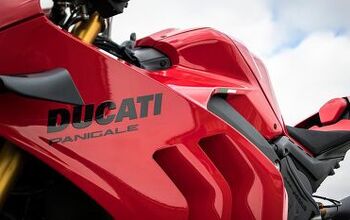
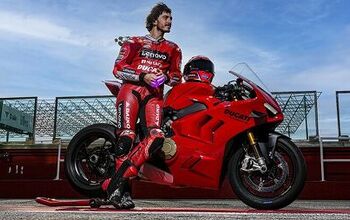
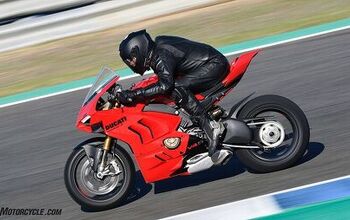
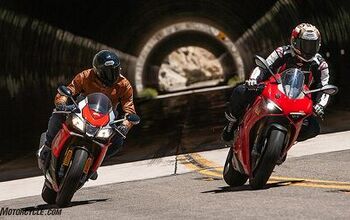






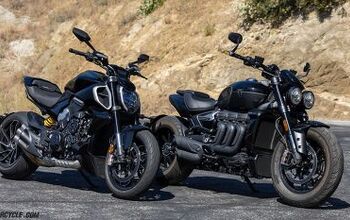

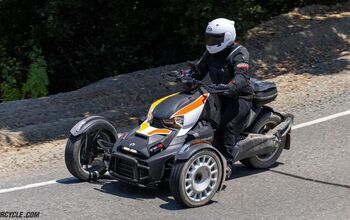


Comments
Join the conversation
They let the guy that designed (ruined) the Monster 937 design the Panigale. He even put the transformer monster engine covers on it.
It's hard to argue with technical progress in superbikes designed as a basis for racing, but I will anyway. It's a mistake to ditch the single-sided swingarm. An extra second a lap may be a big deal, but not so much when your current bike is already at the sharpest end of the competition. Is Ducati willing to trade off hundreds of sales to get that second?